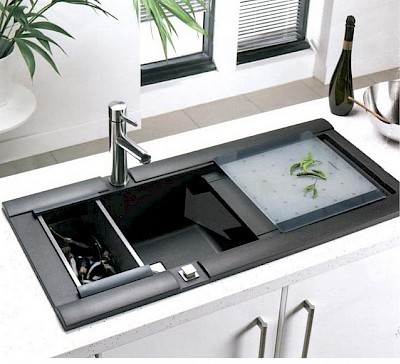Mold, Germs and Bacteria in Undercounter Sinks
I see this all the time.
People get so excited when they walk into a new or renovated kitchen and they see all those beautiful granite or quartz countertops. They ooh and ahhh when they see a lovely under-the-counter or under-mount type sink and fall in love.
Have you ever wondered why kitchen sinks don't have overflow holes?
The truth is that sinks with overflow holes are not allowed in food preparation areas. The overflow areas provide a perfect environment for bacteria and mold to grow - stuff you might not want to add to your soup or sauce as an added ingredient.
Undermount sinks
Of course, in general, all the area around sinks should be kept very well sealed and caulked in order for them to be easily maintained and kept sanitary. Whether the sinks are self-rimming or under-mount the connection between the two should be properly caulked, and even checked for wear from time to time. You can bet that it's one of the things I'm looking for when I do an inspection. And when I renovated my home, much to my wife's chagrin, there wasn't going to be a fancy undermount sink, and thus no possibility of mold, mildew or bacteria to grow. I'm not a "complete" germophobe, but I do like a clean and safe kitchen to work in and I'm sure you do too. The undermounted sinks, with a negative reveal is the worst culprit for bacteria and mold growth.
By far, the easiest to maintain is the molded plastic or composite type sinks where the sink is actually a seamless part of the countertop. There are no areas for bacteria to enter and grow. The flush mount undermount sink, where the counter is cut flush to the edge of the sink, (and has a neutral flush or zero reveal) and has a clear caulk seal is probably the best solution if you want undermounted because there's less chance for bacteria growth.
Under-mount sinks are very fashionable these days. People love the nice "clean" look. Yet, they are without a doubt, less sanitary than a self-rimming type unless one is very vigilant in cleaning the underside of the countertop, where the sink is caulked to the bottom side - (in that little "nook" that's created under the counter inside the sink). Add to this, in the case of granite - that the underside of the overhang is actually unfinished - an ideal place for mold and bactia to grow happens. (Check the underside of your toilet tank where there is no enamel coating to see what I'm talking about.) Gross, right?
The apron sink is very popular with the "farmhouse" kitchen look, and it is an overmount in some cases, with a larger lip between the countertop and sink area, which makes it much harder for small crannies of bacteria to find egress into the sink. But in most cases it's an undermount on the top (which can be problematic) and overmount on the apron side. But it's not a look for everyone. Modern kitchens someitmes have a modified stainless apron, which is another option. After it is installed, ensure that your farmhouse sink is correctly sealed around ALL the edges. Designing the countertop so it overhangs the edges of the sink sufficiently will help water flow straight into the sink bowl and keep it away from the edges.
Mold is good in cheese, and all of us foodies are really loving the whole fermented thing. But we don't want any bad bacterias anywhere where we're preparing our "signature dishes".
I've included a few overmounted sinks to show that they don't have to be "ugly" but quite beautiful!



